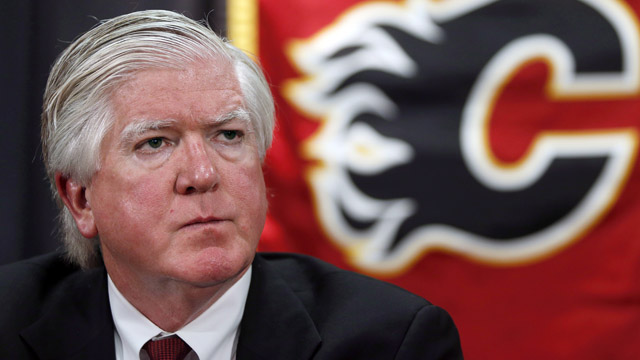BOCA RATON, FLORIDA — Niklas Kronwall’s shot glanced off of Jarret Stoll and flew so far over the glass that everybody lost sight of it. Well, everybody wearing black and white striped jerseys missed it, anyhow.
What happened next could help to shape the week here in Boca Raton, where the 30 National Hockey League general managers hold their annual three-day meetings beginning Monday.
That puck came down out of the heavens, hit Los Angeles goalie Jonathan Quick just below and to the left of his name bar, and trickled into the net for the game-tying goal with 47 seconds to play. Detroit would go on to win in a shootout — two free points, courtesy the veteran officiating crew of referees Dan O’Halloran and Rob Martell and linesmen Mike Cvik and Don Henderson.
The error was bad. But the worst thing was, before the puck had been dropped at centre ice every single player, fan, coach or media member inside Joe Louis Arena knew the goal was bogus; same for everyone at the NHL Video Review Room in Toronto. But they couldn’t do a damned thing about it, because video review, as we know it today, does not allow the reviewing of pucks going over the glass.
As baseball slowly expands its video review process, as does the National Football League and National Basketball Association, what do hockey’s GMs think today?
“I think we should have a coach’s challenge. I’ve brought it up before,” Boston GM Peter Chiarelli told Sportsnet on the weekend.
“I’m OK with the coach’s challenge,” echoed San Jose GM Doug Wilson.
“I believe it’s going to come,” said Calgary’s acting GM Brian Burke.
“A coach’s challenge would take care of that (call in Detroit),” said Edmonton GM Craig MacTavish, who also thought that it would take some pressure off of the officials. And it might.
But it should be said, for the good officials it’s not about pressure. Every referee we’ve ever met would rather the call be righted, regardless of embarrassment. Besides, reversing a call takes only a moment. Seeing that bad Kronwall goal on television for 24 hours — and knowing a bad goal stood up and changed the standings — is far tougher on a ref than one missed call.
“I’m sure that’s how they all feel,” Carolina GM Jim Rutherford said of officials in general. “It’s tough on them ’cause the game’s so fast. Whatever can be done to help them, it makes sense.”
The league worked harder this year to keep the Boca Raton agenda under wraps, but we know the subject of fighting will be re-assessed here. And that old standard – concussions caused by back pressure body checks or unnecessarily high hits — has fallen down the to-do list somewhat. Whether or not The Quiet Room ever worked out the way it was intended, you have to admit, those Mike Richards-on-David Booth hits have been nearly eliminated by rules shaped at these meetings.
“(Concern regarding concussions) is ongoing,” said Rutherford, who will hear an updated report on the statistics of head injuries in the NHL, along with 29 other GMs. “We have the best experts continuing to look at how we can make it better. We may not discuss it as much, but that’s because we know the league is absolutely on top of it.”
The game isn’t perfect. But today, the mandate of the 30 GMs is more about sanding off the rough edges than rebuilding the foundation. Burke has added a request to the agenda that any new arenas being built include a cooling pad of “90 or 91 feet,” in case the NHL ever decides to widen its ice surface. That is still not as wide as the Olympic standard of 98 feet.
“I’ve been pushing for this since Pittsburgh built their new arena,” Burke said. “I’ve asked Edmonton to do it too. And the Islanders, if they build a new rink.”
MacTavish, who’s Oilers saw construction begin their new arena only last week, was in complete agreement.
“We need more space. Guys are too big, too fast,” he said. “The bigger ice promotes passing. I’d rather see four or five crisp passes to enter the zone than the chip and chase we’re seeing now.”
After watching the Olympics however, the wider ice debate could be ill timed. Even if including it in new construction does not mean change is imminent.
These meetings are the place to bring up ideas like Burke’s however, and when it comes to the rules, director of officiating Stephen Walkom is a new age, forward-thinking guy. A former on-ice official, Walkom will lead these GMs towards helping referees get the calls right without opening the can of worms that would have every bit of minutiae liable for review.
“We’ve always made the in-game experience, the live fans, our top priority. That cannot change,” Burke said. “The scope of review, the number of calls and the frequency of the review, those are all things that can be lethal to our paying customer.”
The question is not whether the scope of reviewable plays will be increased. It’s about how much?
The NFL’s review process is considered by most hockey men to slow the game down too much. Most GMs admit that missed calls are few and they even out over the course of the season, though they all change their tune after a bad call in game seven.
Sure, there must a way to erase that Kronwall goal. But what about an offside call that was missed right before a goal was scored? And what if that offside occurred three line rushes back, but there hadn’t been a whistle for a couple of minutes and a goal is scored?
“How far back can you go? How long do want to unwind the play?” asks Chiarelli.
It’s a fine question. And exactly what these meetings are all about.


